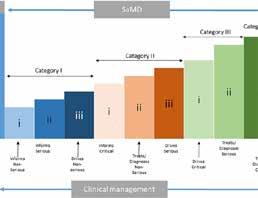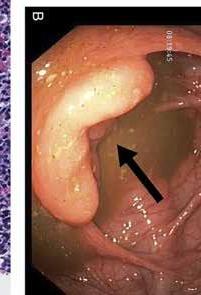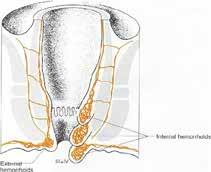
9 minute read
INSIDE THE JOURNALS
ACGCASEREPORTS.GI.ORG CASE REPORTSACG VOLUME 6JOURN L ACGCASEREPORTS.COM CASE REPORTSACG VOLUME 6JOURN L
An Online Journal of Case Reports edited by Gastroenterology & Hepatology FellowsAn Online Journal of Case Reports edited by Gastroenterology & Hepatology Fellows THE RED JOURNAL ENTERS AN IMPORTANT NEW ERA of its history as it welcomes new Co-Editors-in-Chief Dr. Jasmohan Bajaj and Dr. Millie Long with the January 2022 issue, and thanks Dr. Brian Lacy and Dr. Brennan Spiegel for their 6-year tenure at the helm of The American Journal of Gastroenterology. Read more about the vision of the new Co-EICS.
Dr. Lacy and Dr. Spiegel also deserve special recognition for their role envisioning and bringing to life the AJG October Special Issue, “Changing Landscape in GI Practice” which also included new ACG Clinical Guidelines on the Management of Benign Anorectal Disorders by Wald, et al.
Recent publications in Clinical and Translational Gastroenterology and ACG Case Reports Journal that received attention and spurred discussion on social media are the picks for “Inside the Journals.” Follow CTG on Twitter @ACG_CTG and follow ACG Case Reports Journal @ACGCRJ. For the Red Journal on Twitter, follow @AmJGastro.


Wald, Arnold MD, MACG; Bharucha, Adil E. MBBS, MD; Limketkai, Berkeley MD, PhD, FACG; Malcolm, Allison MBBS, FRACP; Remes-Troche, Jose M. MD, MsC; Whitehead, William E. PhD; Zutshi, Massarat MD The American Journal of Gastroenterology: October 2021 - Volume 116 - Issue 10 - p 1987-2008 DOI: 10.14309/ajg.0000000000001507
These updated guidelines summarize the definitions, diagnostic criteria, evaluation, and management of a group of benign disorders of anorectal function and/or structure. Disorders of defecation, proctalgia syndromes, and fecal incontinence are primarily regarded as disorders of function; some patients also have structural abnormalities. The structural disorders include acute and chronic anal fissures and hemorrhoids. The guidelines consist of individual sections that cover the definitions, epidemiology and/or pathophysiology, diagnostic testing, and treatment recommendations.
READ: bit.ly/ajg-wald-anorectal LISTEN: bit.ly/ajg-wald-podcast

Origins and location of internal and external hemorrhoids.
As the final issue of The American Journal of Gastroenterology published under the leadership of outgoing Co-Editors-in-Chief, Brian E. Lacy, MD, PhD, FACG and Brennan M. R. Spiegel, MD, MSHS, FACG, the October 2021 Red Journal special edition was dedicated to the changing landscape in gastroenterology. In their accompanying editorial, Dr. Lacy and Dr. Spiegel wrote: “We have witnessed striking advances in our field that are improving quality of life and prolonging survival among patients with digestive disorders. Although some of these innovations might have been envisioned when we were clinical trainees, many were nearly inconceivable at the time.
These types of massive advances were an impetus for designing this special edition of The American Journal of Gastroenterology, which focuses on the changing landscape of gastroenterology and hepatology. The advent of new techniques, new therapies, and even new disorders (e.g., COVID-19–associated gastrointestinal and liver pathology) that are changing the everyday landscape of daily practice warrant dissemination to the scientific community.”
READ: bit.ly/ACG-Oct-2021-Landscape
Welcome New AJG Co-EICs Dr. Bajaj and Dr. Long
The American College of Gastroenterology announced new Co-Editors-in-Chief of The American Journal of Gastroenterology in July 2021. The team of Jasmohan S. Bajaj, MBBS, MD, MS, FACG and Millie D. Long, MD, MPH, FACG were approved by the ACG Board of Trustees thanks to their deep experience as AJG Associate Editors, their individual reputations as clinician-scientists, and their national leadership in the fields of gastroenterology and hepatology. They assume their new roles with the January 2022 issue.
Together Dr. Long and Dr. Bajaj will continue AJG’s tradition of clinical and educational excellence, along with ensuring diversity, prompt decisions, and focus on prospective experiences and randomized trials across the field of gastroenterology. They will be partners in leading ACG’s flagship journal into its next era.
“I believe that AJG is the premier clinical journal in the field of gastroenterology and hepatology and its strength is in its clinical relevance and applicability,” said Dr. Long. “As Co-Editors-in-Chief, Dr. Bajaj and I will continue to foster that key strength and aim to publish clinically applicable manuscripts of interest to practicing clinicians that will improve the care of patients with gastrointestinal disorders,” she added.
“The overall ethos is for the Red Journal to bolster the standing it currently holds as a ‘one-stop shop’ where our clinical readership can enhance their practice and patient management skills,” Dr. Bajaj said. “The overall vision for the journal is to ensure it continues to further the mission of the College and expands its reach, ensuring inclusivity while threading the needle between novelty, innovation, and education.”
The new Co-Editors-in-Chief view the clinical guidelines developed by College members as practical, important, useful, and highly relevant to patient care. Guidelines will continue to be a centerpiece of the Red Journal, along with clinically relevant manuscripts and initiatives, pertinent clinical review articles, a continuation of the “How I Approach It” series, and an enhanced focus on clinical education.
Shared Leadership: An AJG Tradition Sharing editorial responsibilities has been a successful model for The American Journal of Gastroenterology since 2004 with the team of Joel E. Richter, MD, MACG and Nicholas J. Talley, MD, PhD, MACG, who, in 2010, were
succeeded by Paul Moayyedi, MB ChB, PhD, MPH, FACG and William D. Chey, MD, FACG. Most recently, since 2016, the journal has moved to new levels of excellence during the tenure of Co-Editors-in-Chief Brian E. Lacy, MD, PhD, FACG, of Mayo Clinic Jacksonville, and Brennan M. R. Spiegel, MD, MSHS, FACG, of Cedars-Sinai Health System.
“Dr. Brian Lacy and Dr. Brennan Spiegel have been amazing leaders of AJG. They have published outstanding work, including leading coverage of GI complications of COVID-19, and a revitalized Red Section of the journal.
Thank You, Dr. Lacy and Dr. Spiegel, for Service to The Red Journal
The College recognizes with deep thanks the editorial leadership and vision of Dr. Brian Lacy and Dr. Brennan Spiegel who have served with distinction as Co-Editors-in-Chief of The American Journal of Gastroenterology since 2016. The individual strengths and unique perspectives they bring to the editorial board have elevated the journal and enhanced its reputation.
Dr. Spiegel and Dr. Lacy are not just thoughtful leaders; they really worked well as a team. They brought to the Red Journal an innovative, inclusive, and pragmatic approach that elevated its reach and impact, engaged members of the GI academic and practice community, and enhanced its scientific quality. They did so while maintaining a highly collaborative and engaged editorial board, a testament to their They have enhanced the digital footprint and the journal’s presence on social media. Through their leadership, the journal has reached new heights. They have also served as outstanding role models within the field of gastroenterology,” commented Dr. Long.
Jasmohan S. Bajaj, MBBS, MD, MS, FACG Millie D. Long, MD, MPH, FACG
ability to organize high functioning teams and delegate effectively.
Examples of the innovations they brought to the journal included a new Red Section, laser-focused on the practitioner audience, with columns such as “How I Approach It” and the patient-centered “In My Own Voice,” a renewed focus on scientificallyfocused special editions such as “The Negative Issue,” and an expanded focus on important clinical areas such as hepatology and international health. Additionally, when the world was swept up by the COVID-19 pandemic, they led the way in the GI world, publishing key articles about ground-breaking work on GI COVID.
Brian E. Lacy, MD, PhD, FACG Brennan M. R. Spiegel, MD, MSHS, FACG
[CLINICAL & TRANSLATIONAL GASTROENTEROLOGY]
Impaired Proximal Esophageal Contractility Predicts Pharyngeal Reflux in Patients with Laryngopharyngeal Reflux Symptoms
Sikavi, Daniel R. MD; Cai, Jennifer X. MD, MPH; Leung, Ryan; Carroll, Thomas L. MD, MPH; Chan, Walter W. MD, MPH Clinical and Translational Gastroenterology: October 2021 - Volume 12 - Issue 10 - p e00408 DOI:10.14309/ctg.0000000000000408
IN OUR COHORT OF PATIENTS WITH LARYNGOPHARYNGEAL REFLUX (LPR) symptoms who were prospectively enrolled and systematically evaluated with high-resolution manometry (HRM) and hypopharyngeal-esophageal multichannel intraluminal impedance-pH testing (HEMIIpH), we found that impaired contractility of the proximal esophagus was independently associated with increased pharyngeal reflux events. This observed risk of increased pharyngeal reflux associated with impaired proximal contractility was particularly elevated among patients without a primary esophageal motility disorder per Chicago classification on HRM. Together, our findings suggest a role for proximal esophageal contractile dysfunction in LPR which may be independent of distal esophageal motility.
READ: bit.ly/ctg-sikavi-etal
Measurement of the PCI on highresolution manometry
[ACG CASE REPORTS JOURNAL]
Endoscopic Mucosotomy and Lumen-Apposing Metal Stent Placement for the Management of a Closed Colorectal Anastomosis
Sánchez-Luna, Sergio A. MD; Sobani, Zain A. MD; Rustagi, Tarun MD. ACG Case Reports Journal: July 2021 - Volume 8 - Issue 7 - p e00616 DOI:10.14309/ crj.0000000000000616 BARIUM ENEMA SHOWED complete obstruction of the colonic anastomosis. Sigmoidoscopy revealed a scar at the site of anastomosis (5 cm from the anal verge), suggesting a complete obstruction of the anastomosis with overlying epithelialization. Endoscopic mucosotomy was performed with puncturing of the overlying mucosa using an injection needle, followed by endoincision using a needle knife. An ultrathin endoscope was passed through the mucosotomy with visualization and confirmation of the upstream colonic lumen. A 20 × 10 mm lumen-apposing metal stent (LAMS; Boston Scientific, Marlborough, MA) was then placed across the anastomotic stricture to reestablish the luminal continuity and effectively dilate the stricture to 20 mm (image right).

Read the Case: bit.ly/acgcrj-sanchez-luna
Lumen-apposing metal stent was placed across the anastomotic stricture.




SUBMIT YOUR APPLICATION for the ACG 2022 International GI Training Grant Awards

The International Relations Commi ee of the American College of Gastroenterology is now accepting applications for the 2022 International GI Training Grants. Each training grant will award one fellowship, with a maximum of $10,000, during 2022. Grants are to be used for travel to and from the training center and to the ACG Annual Meeting, as well as for incidental expenses related to the training. The training must take place between July 1, 2023, and June 30, 2023.

INTERNATIONAL GI TRAINING GRANT
This grant provides partial fi nancial support to physicians outside the United States and Canada to receive clinical or clinical research training or education in Gastroenterology and Hepatology in selected medical training centers in North America.
WHO IS ELIGIBLE? Physicians who are not citizens or residents of the United States or Canada, and who are working in gastroenterology or related areas, are eligible to apply together with their training institution.
This grant provides partial fi nancial support to United States and Canadian GI Fellows in training, or GI Physicians who have completed their training within the last fi ve years, to receive clinical or clinical research training or education in Gastroenterology and Hepatology outside of North America.
WHO IS ELIGIBLE? GI Fellows in training who are enrolled in an accredited gastroenterology fellowship program, or GI Physicians who completed their training within the last fi ve years, and are citizens of the United States or Canada, are eligible to apply together with their training institution.





